April Gardening Tips 2024
After such a wet winter, surely we must be in line for some sunshine. I do hope so because April is such an exciting month in the garden.
Spring colour is always the most vibrant of the year, whether it is the almost iridescent green of the new leaves on the trees, spring flowering bulbs, alpines such as pretty Saxifrage (London Pride), Aubretia, Dianthus and Lithodora, or early flowering shrubs such as Chaenomeles (Japanese Quince), Ribes and Forsythia bursting into joyful flower. Yet there is still the promise of so much more to come.
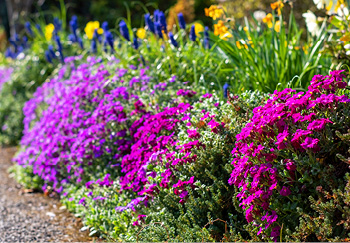
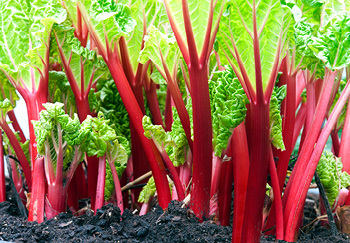
Colour doesn’t have to be confined to ornamental subjects. The Rhubarb in my garden is doing well and I love its bright pink stems. Vegetable and salad crops also have a beauty of their own. This is a great time to sow vegetable seed (or plant young plants) in succession for the longest possible cropping season, especially beans, salad crops and peas.
Sow under cover and plant out a little later on to avoid frost damage. Sow tomatoes in pots in the greenhouse or on a windowsill. There is still time to plant potatoes. Earth them up as soon as the shoots emerge. This helps the tubers to form deep enough that they don’t turn green. Grow vegetables you really like to eat and add in something new for a change too.
For a bright and beautiful lawn, clear winter debris and give it a good rake to ‘scarify’ and remove dead grass, smaller twigs and general detritus. Where the lawn has become compacted, aerate with a hollow tine fork or aerator. This will allow air and water to penetrate to the roots. You can also apply a lawn fertiliser to give the grass a real boost and help it withstand all the use it will get over the summer and any potential (dare I say it) dry spells. For the first few cuts of the year keep the mower blades quite high. This is also an ideal month to sow a new lawn or to re-seed areas that have become worn.
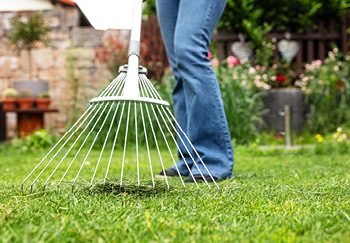
You can plant all sorts of shrubs, trees, roses, climbers and perennials, or cottage garden plants now. There are some great performing easy care shrubs to choose from such as Choisya and Photinia which are really reliable plants to help form the backbone of the garden, leaving plenty of scope for infilling with more opulent flowering subjects. It is worth taking some time over planting. Dig a good-sized hole to accommodate your plant. Add some fertiliser and compost to the bottom of the planting hole. I also add some Root Grow (mycorrhizal funghi) at home because I find it helps plants to establish really well, especially roses. Place your plant in the hole. Back fill with some more compost and garden soil, firm lightly and water in well. It is important to keep newly planted subjects well-watered throughout the first growing season, and beyond if the weather is dry.
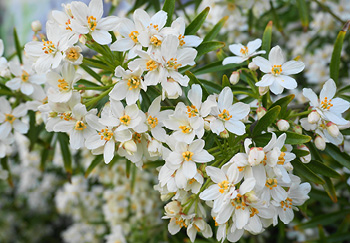
There is still time to buy and plant summer flowering bulbs. Scented lilies, gorgeous gladioli, dancing dahlias, exotic looking agapanthus, retro begonias and a host of other corms, tubers and rhizomes to give you wonderful colour later in the summer, and perhaps even some flowers to cut for the house. They are so easy to pop in the ground and great for filling gaps in the border.
Less glamorous but no less rewarding are a few well timed housekeeping tasks. Finish pruning the roses (except ramblers), tie in in the new shoots of climbing roses and clematis while they are still soft and bendy enough to do so. This will promote an even spread of foliage and flowers. Otherwise, you can end up with a mass of intertwined stems. Beware, the new shoots are quite fragile and liable to break. Prune early flowering spring shrubs such as Ribes and Forsythia once they have finished flowering.
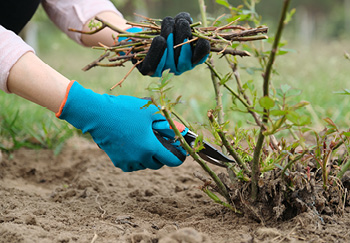
Dead head faded Daffodils, Tulips and Hyacinth, but do not cut the foliage back just yet because the bulbs need this to photosynthesise to feed the bulb beneath the soil and promote great flowers again next year. Applying a general fertiliser around the clumps will also benefit the plants for next year. Mulch the borders with homemade compost, well-rotted manure or bark to help with weed control and water retention. It is amazing how much better the borders will look for it immediately and your plants will thank you for it in the long run too.
While there is never a dull moment in any garden, April must be one of the busiest and most rewarding months in the calendar. And there is more daylight to enjoy too. I hope you have a lovely time in your outdoor space this month, however large or small.






